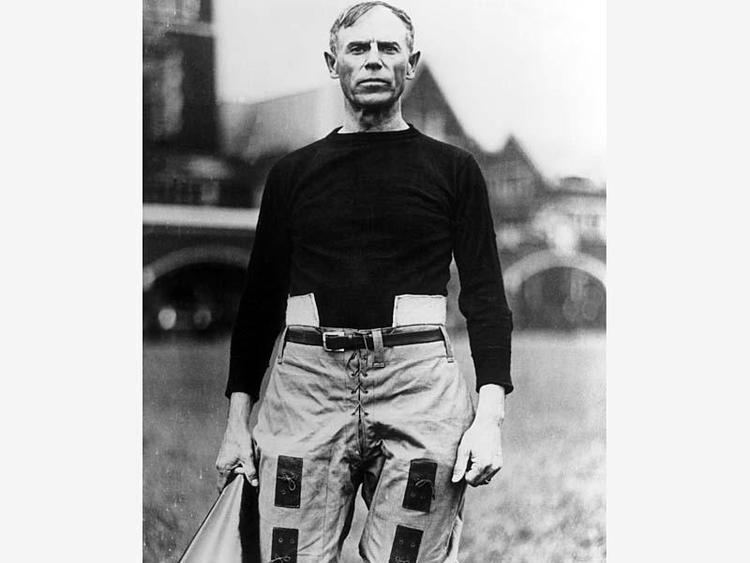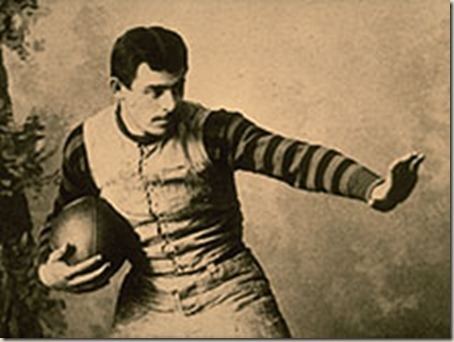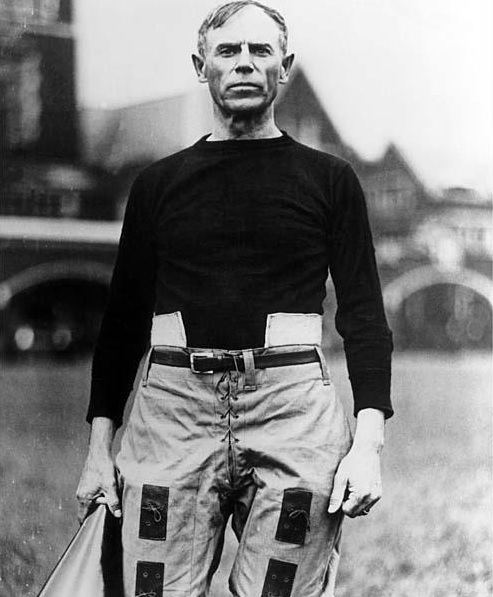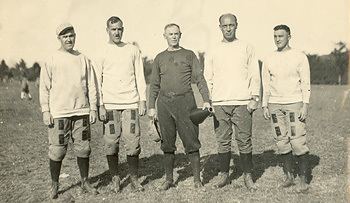Books Principles of Football 1893–1894 Buchtel | 1892 Oberlin Name John Heisman | |
 | ||
Born October 23, 1869Cleveland, Ohio ( 1869-10-23 ) Died October 3, 1936, New York City, New York, United States Similar People Jay Berwanger, Collin Klein, Walter Camp | ||
John heisman becomes the first
John William Heisman (October 23, 1869 – October 3, 1936) was a player and coach of American football, basketball, and baseball, as well as a sportswriter and actor.
Contents
- John heisman becomes the first
- Early life and playing career
- Coaching career
- Oberlin
- Buchtel
- Auburn
- Clemson
- Georgia Tech
- Baseball and basketball
- Football
- Penn and Washington Jefferson
- Rice University
- Acting career
- Personal life
- Death and legacy
- Legacy
- Coaching tree
- References

He served as the head football coach at Oberlin College (1892, 1894), Buchtel College (now known as the University of Akron) (1893–1894), Auburn University (1895–1899), Clemson University (1900–1903), Georgia Tech (1904–1919), the University of Pennsylvania (1920–1922), Washington & Jefferson College (1923), and Rice University (1924–1927), compiling a career college football record of 186–70–18. His 1917 Georgia Tech Golden Tornado were recognized as the national champion.

Heisman was the head basketball coach at Georgia Tech (1908–1909, 1912–1914), tallying a mark of 9–14, and the head baseball coach at Buchtel (1894), Clemson (1899–1904), and Georgia Tech (1904–1917), amassing a career college baseball record of 219–119–7. He served as the athletic director at Georgia Tech from 1904 to 1919 and at Rice from 1924 to 1927. While at Georgia Tech, he also was president of the Atlanta Crackers baseball team.

Fuzzy Woodruff dubbed Heisman the "pioneer of Southern football". Heisman was inducted into the College Football Hall of Fame as a coach in 1954. His entry there notes that Heisman "stands only behind Amos Alonzo Stagg, Pop Warner, and Walter Camp as a master innovator of the brand of football of his day". One writer says Heisman, Stagg, and Warner constitute the "Football Trinity". The Heisman Trophy, awarded annually to the season's most outstanding college football player, is named after him.

Early life and playing career

Heisman was born in Cleveland, Ohio, the son of Bavarian German immigrant Johann Michael Heissmann and Sara Lehr Heissman. He grew up in northwestern Pennsylvania near Titusville, where he played varsity football for Titusville High School from 1884 to 1886, and was salutatorian of his graduating class. Although he was a drama student, he confessed he was "football mad." Heisman's father refused to watch him play at Titusville, calling football "bestial".

He went on to play football as a lineman at Brown University (1887–1888) and at the University of Pennsylvania (1889–1891); "a 158-pound center ... in constant dread that his immediate teammates—guards weighing 212 and 243—would fall on him." He graduated from the University of Pennsylvania Law School in 1892.
Coaching career
In his book Principles of Football, Heisman described his coaching strategy: "The coach should be masterful and commanding, even dictatorial. He has no time to say 'please' or 'mister'. At times he must be severe, arbitrary, and little short of a czar." Heisman always used a megaphone at practice.
Oberlin
Heisman first coached at Oberlin College in 1892. Wrote The Oberlin Review in 1892: "Mr. Heisman has entirely remade our football. He has taught us scientific football." Influenced by Yale and Pudge Heffelfinger, Heisman implemented seven-man interference. His best lineman at Oberlin was the half German, half Hawaiian John Henry Wise. Heisman also used a fake pass (from center) and a double pass. Heisman returned to Oberlin in 1894.
Buchtel
In 1893 he moved to Buchtel College, where he helped make the first of many permanent alterations to the sport of football. It was then customary for the center to begin a play by rolling the ball backwards, but this was troublesome for Buchtel's unusually tall quarterback, Harry Clark. Under Heisman, the center began tossing the ball to Clark, a practice that evolved into the snap that today begins every play.
Auburn
In 1895 Heisman became the fifth head football coach at Auburn University. He witnessed one of the first illegal forward passes. His 1895 team once executed a "hidden ball trick" in a game against Vanderbilt while appearing to run a revolving wedge. Vanderbilt won nevertheless, 9 to 6; it was the first time in the history of southern football that a field goal decided a game. "Billy" Williams recalled:
I was playing left half for Auburn and Tichenor was quarterback. We were on Vandy's 15-yard line and had the ball in our possession. Tich passed the ball to me; I raised his jersey and hid the ball under it, at the same time dashing toward our right end, protected by several members of the Auburn team ... Vandy thought I had the ball. Tich journeyed around his own left and went over the Vanderbilt's goal line. The first time the Vandy players knew Tich had the ball and had made a touchdown was when they saw him pulling the ball from under his jersey.
Quarterback Reynolds Tichenor described the nature of the play as follows:
The play was simply this. When the ball was snapped it went to a halfback. The play was closely massed and well screened. The halfback then thrust the ball under the back of my jersey. Then he would crash into the line. After the play I simply trotted away to a touchdown.
The 1899 team lost just one game, by a single point to the "Iron Men" of Sewanee, and ran an early version of the hurry-up offense. As Heisman recalled:
The team of '99—my last at Auburn—was a great one. It only weighed about 160 (pounds per player), but its speed and team work were something truly wonderful. I do not think I have ever seen so fast a team as that was. It would line up and get the ball in play at times before the opposing players were up off the ground. You see it was a 'stunt' of ours to catch them off side and get the benefit of the penalty. Nowadays no team is taken by surprise by such lightning lining up; but that Auburn team of '99 was the first to show what could be done with speedy play, and then it wasn't long before all other teams were laboring with might and main to inject speed into their work.
Fuzzy Woodruff relates on All-Southern selections: "The first selections that had any pretense of being backed by a judicial consideration were made by W. Reynolds Tichenor, old-time Auburn quarterback, who had kept in intimate contact with football through being a sought-after official. The next selections were made by John W. Heisman, who was as good a judge of football men as the country ever produced." Heisman drew much acclaim as a sportswriter.
Clemson
In 1900 Heisman, then "the undisputed master of Southern football", went to Clemson University, where he coached four winning seasons and three Southern Intercollegiate Athletic Association (SIAA) titles. Auburn graduate Walter Riggs led the effort to raise the $415.11 to hire Heisman, the first Clemson coach who had experience coaching at another school. As Riggs recalled, "By 1899 the Clemson football team had risen steadily until its material was equal to that of any southern college, and the time had come to put on the long-planned finishing touch." Heisman once described his style of play at Clemson as "radically different from anything on earth". On opening day in 1900, Clemson beat Davidson by a 64–0 score, which was then the largest ever made in the south.
The 1901 Clemson team was tied by Tennessee. The 1902 team beat Tennessee 11–0, during which the Volunteers' Tootsie Douglas launched a 109-yard punt (the field length was 110 yards in those days). Heisman described the kick:
The day was bitterly cold and a veritable typhoon was blowing straight down the field from one end to the other. We rushed the ball with more consistency than Tennessee, but throughout the entire first half they held us because of the superb punting of "Toots" Douglas, especially because, in that period he had the gale squarely with him. Going against that blizzard our labors were like unto those of Tantalus. Slowly, with infinite pains and a maximum of exertion, we pushed the ball from our territory to their 10-yard line. We figured we had another down to draw on, but the referee begged to differ. He handed the ball to Tennessee and the "tornado." Their general cheerfully chirped a signal—Saxe Crawford, it must have been—and "Toots" with sprightly step, dropped back for another of his Milky Way punts. I visualize him still, standing on his own goal line and squarely between his uprights. One quick glance he cast overhead—no doubt to make sure that howling was still the same old hurricane.
I knew at once what he proposed to do. The snap was perfect. "Toots" caught the ball, took two smart steps and—BLAM!—away shot the ball as though from the throat of Big Bertha. And, say, in his palmiest mathematical mood, I don't believe Sir Isaac Newton himself could have figured a more perfect trajectory to fit with that cyclone. Onward and upward, upward and onward, the crazy thing flew like a brainchild of Jules Verne. I thought it would clear the Blue Ridge Mountains. Our safety man, the great Johnny Maxwell, was positioned 50 yards behind our rush line, yet the punt sailed over his head like a phantom aeroplane. Finally, it came down, but still uncured of its wanderlust it started in to roll—toward our goal, of course, with Maxwell chasing and damning it with every step and breath. Finally it curled up and died on our one-footline, after a bowstring journey of just 109 yards.
In 1902 Clemson lost 12–6 to South Carolina in Columbia, for the first time since 1896, when their rivalry began. Several fights broke out that day. As one writer describes, "The Carolina fans that week were carrying around a poster with the image of a tiger with a gamecock standing on top of it, holding the tiger's tail as if he was steering the tiger". Another brawl broke out before both sides agreed to burn the poster in an effort to defuse tensions. The immediate aftermath resulted in the suspension of the rivalry until 1909.
The 1903 team tied Cumberland 11–11 in a game billed as the championship of the South. Clemson's 73–0 victory over Georgia Tech led Clemson to name a street on the campus for Heisman and led Georgia Tech to hire him for the following season. Rival school Georgia offered a bushel of apples for every point over 29 Clemson could score on Tech (the week before, Clemson had beaten Georgia 29–0.). Clemson then rushed for 615 yards. Star players for Clemson under Heisman included Vedder Sitton, Hope Sadler, and Jock Hanvey. One publication reads: "Vetter Sitton and Hope Sadler were the finest ends that Clemson ever had perhaps."
Georgia Tech
Heisman moved from Clemson to Georgia Tech in 1904, where he coached for the longest tenure of his career, 16 years. A banner proclaiming "Tech Gets Heisman for 1904" was strung across Atlanta's Piedmont Park. Heisman was hired by Tech for $2,250 a year and 30% of the home ticket sales, a $50 raise over his Clemson salary. Later in his time at Tech, his salary went up but the percentage of receipts went down.
Baseball and basketball
At Georgia Tech, Heisman coached basketball and baseball in addition to football. Heisman eventually coached track as well and became the head of the Atlanta Baseball Association and the athletic director of the Atlanta Athletic Club. He cut back on these expanded duties in 1918, when he only coached football between September 1 and December 15.
Football
Heisman won 77% of his football games and put together 16 consecutive non-losing seasons, including three undefeated campaigns and a 32-game undefeated streak. Georgia Tech is where Heisman first utilized the jump shift.
His first season was a strong 8–1–1 performance, the first winning season for the school since 1893. One source relates: "The real feature of the season was the marvelous advance made by the Georgia School of Technology which burst from fetters that kept it in the lowest class for ten years." His team posted victories over Georgia, Tennessee, University of Florida at Lake City, and Cumberland, and a tie with his previous employer, Clemson. He suffered just one loss, to another first year coach, Mike Donahue of Auburn. The 1905 team went 6–0–1, and Heisman gained a reputation as a coaching "wizard".
In 1906 the rules committee legalized the forward pass, for which Heisman was instrumental. The 1906 team beat Auburn for the first time. Stars of this early period for Tech included Lob Brown and Billy Wilson. The 1907 and 1908 teams were led by Chip Robert and "Twenty Percent" Davis, who was captain in 1909.
The team continued to post winning records but with multiple losses each season. The 1911 team featured future coach William Alexander as a reserve quarterback, and was captained by Pat Patterson. Alf McDonald made an All-Southern team in 1912, and the team moved to Grant Field from Ponce de Leon Park (where the Atlanta baseball team also played) by 1913.
1915–1918
From 1915 to 1918 Georgia Tech went 30–1–2 and outscored opponents 1611 to 93. The 1915 team was immediately dubbed the greatest in Tech's history. One writer claimed the 1916 team "seemed to personify Heisman". This was the first team to vault Georgia Tech to national prominence. In a game played in Atlanta in 1916, Heisman's Georgia Tech squad defeated the Cumberland College Bulldogs, 222–0, in the most one-sided college football game ever played. Heisman's running up the score against his out-manned opponent was supposedly motivated by revenge against Cumberland's baseball team for running up the score against Tech 22–0 the previous year with a team primarily composed of semi-pro players, and against sportswriters he felt were too focused on numbers.
In 1917, the backfield of Everett Strupper, Joe Guyon, Al Hill, and Judy Harlan helped propel Heisman to his finest success, a national championship, the first for a southern team. The team produced the first two players from the Deep South ever selected All-American: Strupper and team captain, tackle Walker Carpenter. Heisman challenged Pop Warner's undefeated Pittsburgh team to a decisive national championship game, but he declined. In the next season of 1918, after losing several players to World War I, Tech lost a lopsided game to Pitt 32–0. Historian Francis J. Powers wrote:
At Forbes Field, the dressing rooms of the two teams were separated only by a thin wall. As the Panthers were sitting around, awaiting Warner's pre-game talk, Heisman began to orate in the adjoining room. In his charge to the Tech squad, Heisman became flowery and fiery. He brought the heroes of ancient Greece and the soldier dead in his armor among the ruins of Pompeii. It was terrific and the Panthers sat, spellbound. When Heisman had finished, Warner chortled and quietly said to his players: 'Okay, boys. There's the speech. Now go out and knock them off.'
Tech eclipsed 100 points three different times in 1918. Buck Flowers, a small back in his first year on the team, was in the backfield after transferring from Davidson a year before, where he had starred in a game against Tech. Flowers had grown to weigh 150 pounds and was a backup until Heisman discovered his ability as an open-field runner on punt returns. "Heisman's eyes bulged. And bulged again. On the first punt, Buck ran through the entire first team. Same thing again ... and again. Heisman had uncovered one of the greatest broken-field runners."
Also in 1918, center Bum Day became the first player from the south selected for Walter Camp's first team All-America, historically loaded with college players from Harvard, Yale, Princeton, and other northeastern colleges.
Penn and Washington & Jefferson
With Bill Alexander hired as his successor, Heisman left Atlanta after the 1919 season, going back to Penn for three seasons from 1920 to 1922. Most notable perhaps is the 1922 loss to Alabama, the Tide's first major inter-sectional victory. In 1923 Heisman coached the Washington & Jefferson Presidents, which beat the previously undefeated West Virginia Mountaineers.
Rice University
Following the season at Washington and Jefferson College, Heisman ended his coaching career with four seasons at Rice. In 1924, after being selected by The Committee on Outdoor Sports, he took over the job as Rice University's first full-time head football coach and athletic director, succeeding Phillip Arbuckle. His teams saw little success, and there was an uproar as he earned more than any faculty member. Rice University was his last coaching job before he retired in 1926 to lead the New York Downtown Athletic Club.
Acting career
Heisman was a Shakespearean actor in the off-season. His oration at his Titusville Highschool graduation entitled "The Dramatist as Sermonizer" was described as "full of dramatic emphasis and fire, and showed how the masterpieces of Shakespeare depicted the ends of unchecked passion." He was known for his use of polysyllabic language. "Heisman's voice was deep, his diction perfect, his tone biting." This is exemplified in his speeches, one of which is given here. He was known to repeat this annually, at the start of each football season, to encourage his team:
What is this? It is a prolate spheroid, an elongated sphere in which the outer leather casing is drawn tightly over a somewhat smaller rubber tubing. Better to have died as a small boy than to fumble this football.
In 1897 the Auburn football team finished $700 in debt, and Heisman directed, produced, and acted in David Garrick to raise the money. As such, he became the founder of Auburn's first theatrical group: The A.P.I. Dramatic Club.
Personal life
Heisman met his first wife, an actress, while he was at participating in theater during his time at Clemson. Evelyn McCollum Cox was a widow with a single child, a boy named Carlisle. They got married during the 1903 season. Carlisle was 12 at the time, and he and Heisman would remain close after John and Evelyn had divorced each other. They decided to separate in 1918 when Heisman was coaching at Georgia Tech and he and Evelyn were living in Atlanta. To prevent any social embarrassment to his former wife, who chose to remain in the city, he left Atlanta after the divorce and took the head coaching position at Penn.
In 1924, while living in Washington, Pennsylvania, and coaching at Washington and Jefferson College, Heisman remarried. He first met Edith Maora Cole when she was a student in Buchtel College, where he was coaching football during the 1893 and 1894 seasons. The two were close but decided not to marry due to Edith's problems with tuberculosis. When they met again in their later years, the two decided to marry; this was in 1924, right before Heisman left Pennsylvania and took his last job as a coach at Rice University in Texas.
Death and legacy
Heisman became the athletics director of the Downtown Athletic Club in Manhattan, New York. In 1935 the club began awarding a Downtown Athletic Club trophy for the best football player east of the Mississippi River.
Heisman died of pneumonia on October 3, 1936, in New York City. Three days later he was taken by train to his wife's hometown of Rhinelander, Wisconsin, where he was buried in Grave D, Lot 11, Block 3 of the city-owned Forest Home Cemetery. When Heisman died, he was preparing to write a history of football.
Legacy
Heisman was an innovator. He developed one of the first shifts: he had both guards pull to lead an end run, and had his center toss the ball back instead of rolling or kicking it. He was a proponent of the legalization of the forward pass in 1906, and he originated the "hike" or "hep" shouted by the quarterback to start each play. He led the effort to cut the game from halves to quarters, and is credited with the idea of the scoreboard and of putting his quarterback at safety on defense.
On December 10, 1936, just two months after Heisman's death on October 3, the Downtown Athletic Club trophy was renamed the Heisman Memorial Trophy, and is now given to the player voted as the season's most outstanding collegiate football player. Voters for this award consist primarily of media representatives, who are allocated by regions across the country in order to filter out possible regional bias, and former recipients. Following the bankruptcy of the Downtown Athletic Club in 2002, the award is now given out by the Heisman Trust.
Heisman Street on Clemson's campus is named in his honor. Heisman Drive, located directly south of Jordan–Hare Stadium on the Auburn University campus, is named in his honor as well. A wooden statue of Heisman was placed at the Rhinelander–Oneida County Airport. Heisman has also been the subject of a musical.
Coaching tree
Heisman's coaching tree includes:
